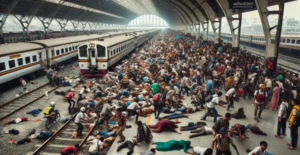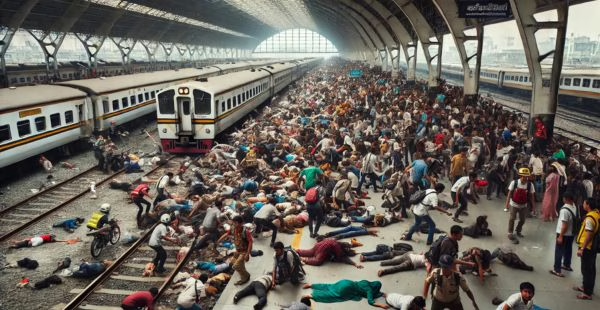
On the evening of February 15, 2025, Delhi Railway Station Stampede turned into a scene of chaos and tragedy, claiming the lives of at least 18 individuals, including women and children, and leaving many others injured. The incident has been attributed to platform mismanagement and overcrowding, particularly as thousands of pilgrims were attempting to travel to the Maha Kumbh Mela in Prayagraj.
The Incident Unfolds
Around 8:00 PM local time, platforms 14 and 15 of New Delhi Railway Station were teeming with passengers eager to board trains bound for the Maha Kumbh Mela, a significant Hindu pilgrimage occurring every 12 years. The station was overwhelmed by the sheer volume of devotees, leading to chaotic conditions.
Confusion escalated when announcements mistakenly indicated the arrival of two trains at different platforms. Passengers were directed to change platforms at the last minute, causing a surge of people moving hastily across the footbridge connecting platforms 14 and 15. In the rush, several individuals slipped and fell, resulting in a domino effect that led to the Delhi Railway Station Stampede 2025. Eyewitnesses recounted scenes of panic as people scrambled to escape the crushing crowd.
Victims and Casualties
The New Delhi train station tragedy resulted in the deaths of at least 18 people, with victims ranging from a seven-year-old child to a 79-year-old adult. The majority of the deceased were women and children, underscoring the vulnerability of these groups in such chaotic situations. Dozens more sustained injuries and were transported to Lok Nayak Jai Prakash Narain Hospital for treatment. The hospital’s emergency services were inundated, highlighting the strain such incidents place on medical infrastructure.
Immediate Response and Rescue Efforts
In the aftermath of the Delhi station stampede, rescue operations were launched promptly. Railway staff, police, and medical teams collaborated to assist the injured and manage the crowd. However, the initial response faced challenges due to the overwhelming number of passengers and the ensuing chaos. Survivors described a scene of confusion, with many individuals frantically searching for loved ones amid the turmoil.
Official Reactions and Investigations
Indian Prime Minister Narendra Modi expressed his condolences, stating he was “distressed by the stampede.” Opposition leaders criticized the inadequate arrangements, especially given the anticipated influx of devotees for the Maha Kumbh Mela. Railway Minister Ashwini Vaishnaw announced a high-level investigation to determine the exact causes of the incident and to prevent future occurrences. A two-member committee, comprising senior railway officials, has been tasked with examining the factors leading to the tragedy and assessing how the New Delhi stampede death toll could have been prevented.
Historical Context of Stampedes in India
India has a history of stampedes, particularly during large religious gatherings. The sheer number of attendees, combined with infrastructural limitations, often creates precarious situations. The Stampede at Indian railway station is a tragic reminder of the need for effective crowd management and infrastructure planning during significant events.
Lessons and the Path Forward
This tragedy underscores the critical importance of meticulous planning and crowd control measures during large-scale events. Authorities must implement strategies such as clear communication, adequate staffing, and infrastructure enhancements to manage large crowds effectively. Ensuring the safety of pilgrims and travelers requires a collaborative effort between government agencies, event organizers, and the public.
Conclusion
The February 15 Delhi Railway Station Stampede serves as a somber reminder of the consequences of platform mismanagement and inadequate crowd control. As India continues to host large-scale events, it is imperative to prioritize the safety and well-being of all participants through comprehensive planning and the implementation of robust safety measures.

